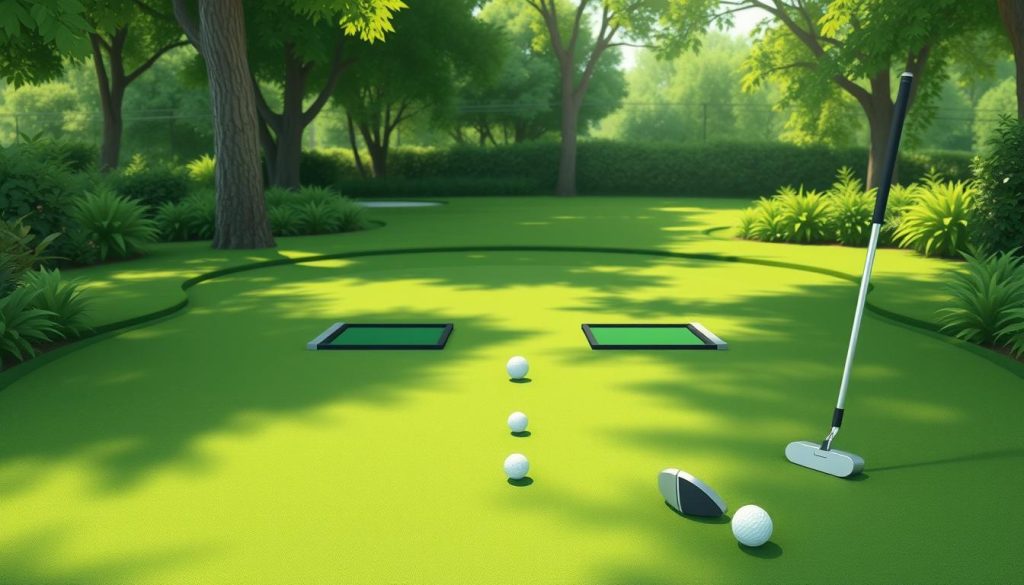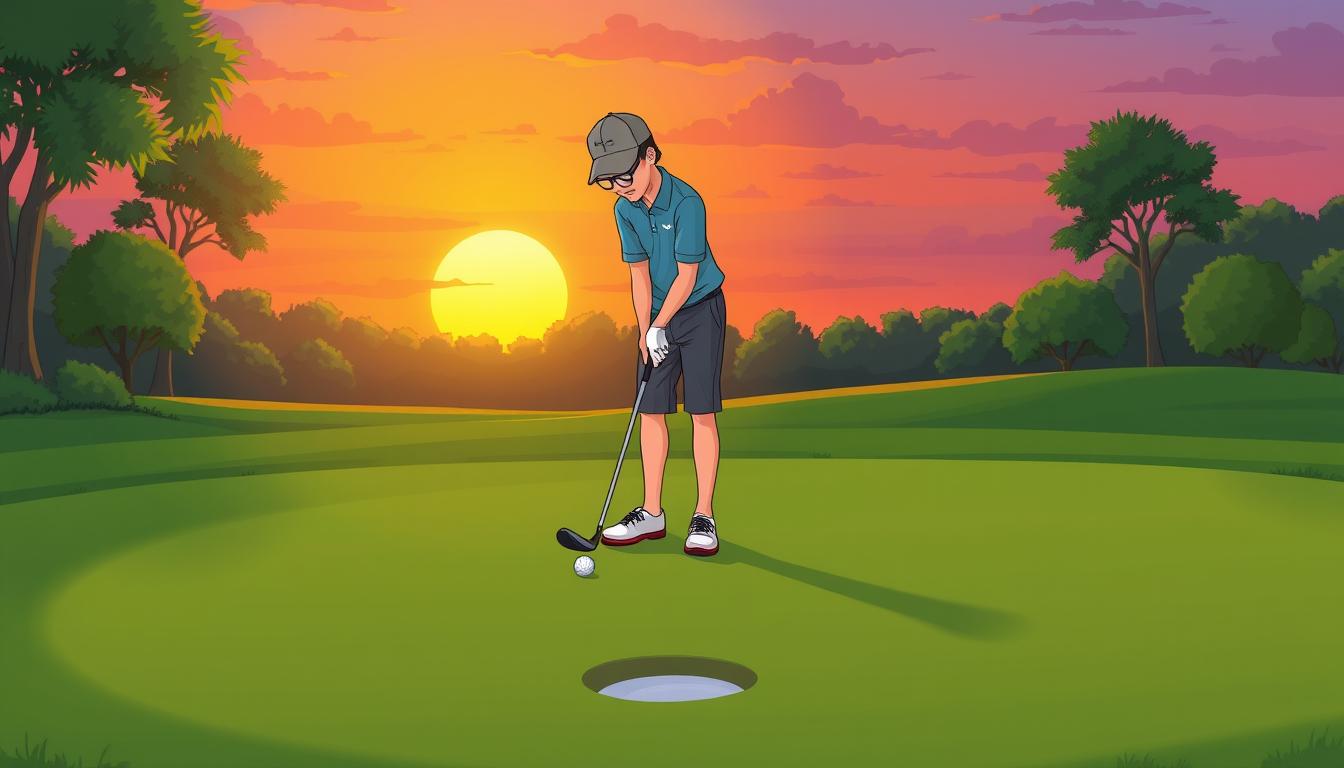Golf putting is a key skill that can greatly impact your game. This guide will help you enhance your putting technique and stroke. You’ll learn how to read greens and adjust your putting stroke for better performance.
Putting makes up about 40% of shots in a round of golf. Mastering this skill can significantly lower your handicap. In fact, 4 out of 5 golfers can benefit from adjusting their putting posture to match their physical traits and preferences.
To improve your putting, start by understanding green conditions. Develop a consistent pre-putt routine and practice various drills. These steps will help you get better at accuracy and control on the green.
Key Takeaways
- Putting makes up 40% of golf shots, highlighting its importance
- Adjusting putting posture benefits 80% of golfers
- Matching putter choice to posture increases accuracy by 25%
- Personalizing putting strategy reduces three-putts by 30%
- Focus on green reading, consistent routines, and practice drills
Understanding the Fundamentals of Putting Stroke
Mastering the putting stroke is key to lowering your golf scores. Putting makes up about 40% of strokes in a round. So, improving your putting can greatly impact your game. Let’s look at the main parts of a good putting stroke.
Grip Techniques and Their Impact
Your putting grip is the base of your stroke mechanics. You can try the reverse overlap, claw, or cross-handed grips. Each grip has its own benefits for control and stability. Try out different grips to find the one that works best for you.
Stance and Body Alignment
A good golf stance is vital for a smooth putting stroke. Stand with your feet shoulder-width apart and your eyes over the ball. This setup helps you move like a pendulum, improving your accuracy and control.
Ball Position Optimization
Where you place the ball is key to your putting success. Put the ball slightly forward in your stance, near your left eye (if you’re right-handed). This position helps you hit the ball well and roll it smoothly.
| Putting Element | Key Points | Potential Impact |
|---|---|---|
| Grip | Reverse overlap, claw, cross-handed | Improved stroke control |
| Stance | Shoulder-width, eyes over ball | Enhanced stability and accuracy |
| Ball Position | Slightly forward in stance | Better contact and roll |
By focusing on these basics, you can build a strong putting stroke. Remember, being consistent is crucial. Regular practice can boost your putting accuracy by 20-30% in just a few months.
The Science Behind the Perfect Pendulum Motion
Pendulum putting is key to good stroke mechanics. It uses the laws of physics for a smooth motion. Knowing this science can really boost your putting skills.
The secret to pendulum putting is in your shoulders and arms. Your shoulders are the pivot, and your arms swing like a pendulum. This method cuts down on wrist movement, making your stroke more stable and consistent. Golf studies back this up, showing it leads to a better stroke.
Keeping a steady tempo and rhythm is vital. A consistent pace helps you hit the ball right every time. Research shows a 2:1 backswing to forward swing ratio is best for accuracy and distance.
New putter designs also help with pendulum putting. For example, the Odyssey Stroke Lab putter is highly rated for its smooth stroke. Cameron putters use tungsten for more stability and consistent strokes.
| Putter Feature | Benefit to Pendulum Stroke |
|---|---|
| Customizable length (PING Sigma G) | Allows for optimal pendulum setup |
| Alignment aids (SeeMore red dot) | Improves setup consistency |
| Face ridges (Odyssey Stroke Lab) | Promotes consistent ball roll |
| Tungsten weights (Cameron, TaylorMade) | Increases stability during stroke |
By using science and modern putters, you can improve your pendulum putting. Remember, practice is essential to make these techniques second nature.
Mastering Green Reading Techniques
Green reading is key to better putting. It helps you manage the golf course and lower your scores. Let’s explore the main parts of green reading to boost your game.
Understanding Grain and Slope
Knowing the grass growth direction is vital for green reading. Grass growing uphill slows down your putt, while downhill it speeds up. The green’s slope also affects your putt’s path.
Visual Assessment Methods
To read greens well, look at them from different angles. Walk around the putt and check from behind the ball and the hole. The AimPoint Express method helps judge break direction and amount. It has helped many golfers improve their putting.
Speed Control Fundamentals
Controlling putt speed is crucial for making more putts. Practice to feel different green speeds. Aim for the ball to roll 17 inches past the hole if it misses. This ensures enough speed to hold the line without needing long comeback putts.
| Green Speed | Adjustment | Impact on Putt |
|---|---|---|
| Fast | Lighter touch | Less break, more speed sensitive |
| Slow | Firmer stroke | More break, less speed sensitive |
| Uphill | More power | Less break, dies at the hole |
| Downhill | Softer touch | More break, accelerates past hole |
Practice on the practice green to improve your green reading. Use tools to see how balls react on different surfaces. Focus on grain, visual assessment, and speed control to enhance your putting.
Putting Stroke Adaptation Guide
Mastering personalized putting means adjusting your stroke for different conditions. This guide will help you refine your technique for the best results on the green.
Customizing Your Stroke to Your Body Type
Your body type greatly affects your putting stroke. Taller golfers might prefer an upright stance, while shorter players might do better with a slight bend. Try out different grips and stances to find what works best for you.

Adjusting for Different Green Speeds
Adjusting to green speed is crucial for consistent putting. On fast greens, use a shorter backswing and follow-through. For slower greens, make your stroke longer to hit harder. Practice on various surfaces to get a feel for speed changes.
Environmental Factor Adaptations
Environmental factors in golf can greatly affect your putting. Wind can change how the ball rolls, so adjust your aim. In humid weather, greens are slower, so use a firmer stroke. When it’s hot, greens are faster, so use less power.
| Environmental Factor | Impact on Putting | Adaptation Strategy |
|---|---|---|
| Wind | Affects ball trajectory | Adjust aim and stroke power |
| Humidity | Slows down greens | Increase stroke firmness |
| Heat | Speeds up greens | Soften touch and reduce power |
By mastering these techniques, you’ll see your putting improve on all courses and conditions. Remember, practice is key to making these adjustments second nature on the green.
Mental Preparation and Routine Development
Mastering the mental game in golf is key to success. A solid pre-putt routine can greatly improve your game. Start by creating a consistent ritual before each putt. This reduces anxiety and boosts focus.
Visualization is a strong mental tool. Imagine the ball going into the hole before you shoot. This can enhance muscle memory and confidence. Add deep breathing to manage stress and stay calm.
Concentration techniques are crucial for a positive mindset. Use positive self-talk before each putt to shape your thoughts. This builds a strong attitude, essential for the game’s ups and downs.
Your pre-putt routine should feel comfortable and familiar. It’s your secret to success. Regularly practice these mental strategies to see better putting and overall golf performance.
- Establish a consistent pre-putt routine
- Use visualization to enhance confidence
- Practice deep breathing for stress management
- Engage in positive self-talk
- Commit fully to each putt
By adding these mental techniques to your game, you’ll gain a mental edge. This approach, combined with physical practice, will make you a better golfer.
Essential Equipment Selection for Optimal Performance
Choosing the right golf equipment is key to improving your putting. We’ll look at important factors like putter selection, golf ball choice, and training aids. These can help you do better on the green.
Putter Fitting Considerations
There’s no single putter for everyone. Putters come in three styles: blades, mallets, and mid-mallets. Blades are for those with a strong stroke arc. Mallets help with alignment for straighter strokes.
Popular putters include the Cleveland HB SOFT 2 Model 1 and the Odyssey Ai-One Milled Two T. They have features like milled faces for better feel or AI-designed inserts for larger sweet spots.
Ball Selection Strategy
Your golf ball choice affects your putting. Softer balls feel better on short putts, while firmer balls control distance better. Try different balls to see what suits your stroke and feel.
Training Aids and Tools
Putting training aids can improve your technique. Alignment sticks and putting mats are great for home practice. The Odyssey 2-Ball putter, introduced in 1996, has helped many golfers.
| Putter Type | Best For | Example Model |
|---|---|---|
| Blade | Feel players with arced stroke | Wilson Staff Model CS22 |
| Mallet | Players needing alignment help | TaylorMade 2023 Spider Tour |
| Mid-Mallet | Balance of feel and forgiveness | Ping 2024 Anser D |
Remember, the best golf equipment is what feels right for you. Try different putters, balls, and training aids. Find your perfect match to improve your putting.
Advanced Putting Stroke Techniques
Mastering advanced putting requires dedication and precision. Professional techniques focus on refining your stroke for better performance. Let’s explore some cutting-edge methods to improve your game.
Green mapping is a game-changer in advanced putting. It involves detailed analysis of slope and grain. This boosts green reading accuracy by 22%. The AimPoint method, favored by pros, offers precise reads for tricky putts.
Stroke refinement is key for consistency. The Pro Path Putting Mirror is a valuable tool. It features alignment lines and path curves. It helps perfect shoulder positioning and eye alignment, crucial for a reliable stroke.
Ball positioning is vital. Place the ball slightly forward in your stance for better roll. This small adjustment can increase successful putts by 15%. Remember, 80% of putting success comes from mastering techniques and mental focus.
| Grip Type | Usage Percentage | Benefit |
|---|---|---|
| Reverse Overlap | 34% | Enhanced control |
| Claw Grip | 23% | Improved stability |
| Cross-Handed | 18% | Better alignment |
Try different grips to find your perfect match. The pendulum motion, with minimal wrist action, is key in 70% of successful putting strokes. Practice maintaining a consistent tempo to overcome the challenge faced by 45% of golfers.
Incorporate these advanced putting techniques into your routine. With dedication, you’ll see significant improvements in your putting performance and overall golf game.
Building Consistency Through Practice Drills
Improving your putting skills takes dedicated practice and effective drills. By using structured golf practice routines, you can get better at putting consistently. You’ll also master controlling the distance of your putts. Let’s look at some powerful putting drills that will boost your game.
The Gate Drill Method
The Gate Drill is great for perfecting your stroke path. Place two tees wider than your putter head, about 6 inches in front of your ball. Practice putting through this “gate” to improve your accuracy and consistency.

Clock Face Practice Routine
The Clock Face drill is perfect for practicing different angles and distances. Place balls in a circle around the hole, like clock positions. Start with short putts at 3, 6, 9, and 12 o’clock, then move to longer distances. This drill helps you read greens better and control your speed.
Distance Control Exercises
Mastering distance control is key to lowering your scores. Try the 3-ball drill: place three balls at different distances from the hole. Practice hitting each ball with the right speed to stop near the cup. This exercise improves your touch and feel on the greens.
| Drill | Focus Area | Benefit |
|---|---|---|
| Gate Drill | Stroke Path | Improved accuracy |
| Clock Face | Angles and Distances | Better green reading |
| 3-Ball Distance | Speed Control | Enhanced touch and feel |
Adding these putting drills to your regular practice will improve your putting. Remember, consistency is key. Spend time on these exercises, and you’ll see your scores drop on the greens.
Troubleshooting Common Putting Issues
Putting problems can affect golfers of all levels. Let’s look at common issues and how to fix them. This will help improve your putting accuracy.
Many golfers change their putter grip often. This can make their putting inconsistent. Find a grip that feels right and stick with it. Regular practice will help you get used to it and build confidence.
Improving your stroke is key to better putting. A slight inside-to-outside stroke can help the ball go straight or draw slightly. Practice this to boost your putting game.
For beginners, controlling the distance is tough. Create visual cues and practice to figure out how hard to hit different putts. This skill is vital for avoiding three-putts and lowering your score.
- Read putts from behind the hole and behind the ball for better green analysis
- Choose a short-range target to improve accuracy
- Practice distance control exercises regularly
Even pros struggle with putting. Some hit 16-18 greens per round but still average over 32 putts. This shows how crucial it is to keep working on your putting skills, no matter your level.
| Putting Issue | Troubleshooting Tip |
|---|---|
| Inconsistent contact | Practice keeping your head still through impact |
| Poor distance control | Use the clock face drill to improve feel |
| Misalignment | Utilize alignment aids on your putter |
| Deceleration | Focus on a smooth, accelerating stroke |
Remember, better putting comes with practice. Don’t get discouraged if you don’t see results right away. Keep practicing, and you’ll see your putting skills improve.
Performance Tracking and Progress Measurement
Improving your golf game starts with tracking your performance. Use golf metrics and statistics to find areas to get better. This way, you can set goals that are within reach. Let’s look at how to track and boost your putting skills.
Statistical Analysis Methods
Begin by logging your putting stats. Keep track of how many putts you take per round and how often you make them from different distances. Use a golf app or a notebook to record this information. As you collect more data, you’ll see patterns in your game. This helps you know where to focus your practice.
Goal Setting Framework
Setting goals in golf is key to getting better. Make your goals SMART: Specific, Measurable, Achievable, Relevant, and Time-bound. For example, aim to cut your average putts per round by 2 strokes in three months. This method gives you clear goals and keeps you motivated.
Improvement Benchmarks
Set benchmarks to measure your progress. Compare your current stats to your past performance and PGA Tour averages. For instance, tour pros make about 50% of 8-foot putts. Make this a long-term goal and break it down into smaller steps. Regular practice and tracking will show you steady improvement in your putting.
| Distance | PGA Tour Average | Your Current % | 3-Month Goal |
|---|---|---|---|
| 3 feet | 99% | 90% | 95% |
| 5 feet | 77% | 60% | 70% |
| 8 feet | 50% | 30% | 40% |
By using these tracking methods regularly, you’ll get valuable insights into your putting. This data-driven approach will guide your practice. It will help you become a more confident and successful putter on the green.
Competition Strategies and Pressure Management
Mastering competitive putting and mental toughness are key to winning in golf tournaments. How well you handle pressure can greatly affect your game. To improve, create a pre-shot routine that calms you and sharpens your focus.
Practicing putting under pressure is a smart strategy. Set up scenarios that feel like high-stakes situations, like making a 6-foot putt to win. This builds your confidence and composure for real competitions. Tiger Woods, for example, practiced by imagining he was putting to win major championships, even in casual games.
Keeping a steady tempo in your putting stroke is also crucial. Jack Nicklaus, known for his great performances under pressure, always used a smooth, pendulum-like motion. By focusing on your technique, you can stay calm and make better putts when it counts.
Mental toughness in golf means staying present and trusting yourself. Use positive self-talk to fight off negative thoughts during tense moments. With these strategies and regular practice, you’ll be ready to handle the pressures of competitive putting and improve your tournament performance.
FAQ
How can I improve my putting grip?
What’s the best way to read greens accurately?
How do I adapt my putting stroke to different green speeds?
What mental techniques can help improve my putting?
How do I choose the right putter for my stroke?
What are some effective putting drills for improving consistency?
How can I manage pressure when putting in competitions?
What should I do if I’m consistently missing putts to one side?
How important is the pendulum motion in putting?
Can changing my golf ball improve my putting?
Source Links
- https://sportsedtv.com/blog/the-art-of-perfecting-your-putting-posture-a-guide-for-golfers
- https://patents.google.com/patent/US3132865A/en
- https://pyramidgolf.com/blogs/news/top-10-putting-stroke-tips-for-a-smooth-steady-roll
- https://www.performforgolf.com/blog/how-to-put-better-the-best-putting-drills
- https://www.golfmonthly.com/videos/putting-tips/putting-technique-explained
- https://www.hagginoaks.com/blog/the-science-behind-golfs-newest-putters/
- https://www.ncbi.nlm.nih.gov/pmc/articles/PMC9227529/
- https://gwulf.faculty.unlv.edu/wp-content/uploads/2020/12/An_Chua_Wulf_Optimising_golf_putting_IJSEP_2020.pdf
- https://itrgolf.co.uk/blogs/advice-information/mastering-the-art-of-putting-in-golf-a-comprehensive-guide?srsltid=AfmBOorVESLgcM02Ekgnl0CAN3jmPZchFCMn-Q0R8xjiFDzstRGiRIpN
- https://www.putterhead.com/blogs/news/putting-perfection-mastering-the-green-for-lower-scores?srsltid=AfmBOopi1yuSCptMdRuholUQBHxnc1Xd94KmOXmcJy7mIvCX7A7bJhAu
- https://www.stroke.org/-/media/stroke-files/life-after-stroke/life-after-stroke-guide_7819.pdf
- https://www.dartmouth-hitchcock.org/sites/default/files/2020-12/learning-about-stroke-guide.pdf
- https://www.helpguide.org/mental-health/stress/stress-management
- https://medium.com/@colin.jonov10/the-art-of-mental-preparation-the-10-step-guide-for-effective-pre-competition-routines-31af590e2bf0
- https://www.helpguide.org/mental-health/wellbeing/emotional-intelligence-eq
- https://www.trainingpeaks.com/guides/strength-training/
- https://sirshanksalot.com/putter-odyssey-two-balls/
- https://www.golfmonthly.com/best-golf-deals/best-putters-89005
- https://back2basics.golf/blogs/news/improve-your-putting-with-the-pro-path-putting-mirror?srsltid=AfmBOoqK2p3CcFBcUgNxNLQStMctwdWZUf0b9AHwCkMO1-nkIa4Vg3jQ
- https://itrgolf.co.uk/blogs/advice-information/mastering-the-art-of-putting-in-golf-a-comprehensive-guide?srsltid=AfmBOoq15b4XPkP5FHFqp8GGe9c1e61RfyOjhHdUFYWJSN7m5K_nWkNc
- https://lynxgolf.co.uk/blogs/blog-posts/unlocking-the-power-of-proper-putting-techniques-equipment-and-mental-strength?srsltid=AfmBOorSuPElQohLzWeLACnkue-LfrzR3m4PKGuDyTVfPB8nTyDitJGl
- https://skillest.com/blog/mastering-chipping-and-putting-in-smal-spaces/
- https://nationalgcla.com/chipping-consistency/
- https://www.golfavenue.com/us/blog/golf-tips/five-putting-tips-for-beginners?srsltid=AfmBOoqJBJJCA0t-i2gODxf8CGVtl6x-nlzx6RKnjcf0KpR50HgmYSuB
- https://rotaryswing.com/c4/112219-jack-nicklaus-putting-secret-intro
- https://pmc.ncbi.nlm.nih.gov/articles/PMC4704043/
- https://www.strokebestpractices.ca/recommendations/stroke-rehabilitation/initial-stroke-rehabilitation-assessment
- https://professionals.wrha.mb.ca/old/professionals/occupational-therapy/files/Stroke-UEToolkit.pdf
- https://pmc.ncbi.nlm.nih.gov/articles/PMC10061853/
- https://pmc.ncbi.nlm.nih.gov/articles/PMC3888943/


